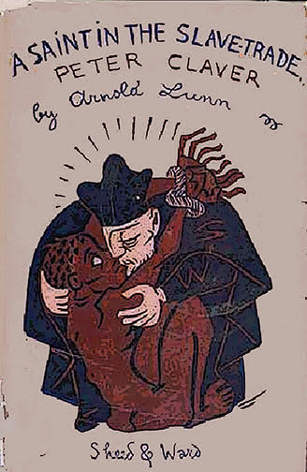Feastdays!
Contemporary Churchy rhetoric might lead you to believe that before the last couple of years, Catholics didn’t know that charity and mercy were at the heart of the Gospel. Surprise! They did! Take a look at our saints for today:
St. Peter Claver
“No life, except the life of Christ, has so moved me as that of St. Peter Claver.”
–Pope Leo XIII

A statue of Peter Claver and a slave in Cartagena.
This is a very good introduction, from a Cartagena page.
From Crisis:
Claver’s heroism in dealing with the diseased and sick is astounding. Even so, it was an everyday occurrence. Claver would wipe the sweat from the faces of the slaves with his own handkerchief. Moreover, he would often clothe the sick and diseased in his own cloak. As some of his interpreters witnessed, the cloak had to be washed up to seven times a day from the stink and filth which it had accumulated. It was routine for Claver to console his fellow man by joyfully undertaking practices which were considered extremely repugnant to most. As one eye-witness notes, “Most admirable was that he not only cleansed these plague-ridden ulcers with the two handkerchiefs he kept for that, but did not hesitate to press his lips to them.” He plainly saw Christ “in the least of these brethren.”
The chief problem in the evangelization of the slaves lay in the numerous languages used by the many “races” of Africans. Although Claver himself never mastered the African languages, he did have some facility with Angolese, the most common of them. On account of these linguistic difficulties, he continually worked with a team of interpreters, black slaves who had a fine ear and tongue for languages. It is important to note that Claver empowered these slave interpreters to become true leaders, diligently training them in the Christian faith. Treating them as his equals, close friends, and true collaborators in the work of evangelization, he always carefully looked after their food, clothing, and medicines. If they were seriously sick, he gave up his bed to them, and slept on the floor.
As images are the books of the illiterate, Claver was liberal in his use of pictures in catechizing the new converts. In his instructions, he taught them the rudiments of the faith. He especially enjoyed teaching them about the life, passion, and death of Christ through illustrations and the crucifix. At times, he even used the monitory pictures of hell to inspire in them a true sense of contrition for their own sins. At the same time, he also gave them hope, teaching them about the glories of heaven. It was not an easy task. The slaves had to be patiently drilled in such simple matters as the sign of the cross. At all times, however, he reminded them of their own dignity and worth, teaching them that Christ had redeemed them at a great price with his blood.
Every spring, Claver would set out on rural missions to plantations surrounding Cartagena. Here he would check up on the lives of his charges as much as he was able. Refusing the hospitality of the plantation owners, he dwelt in the Negro slave quarters. On many occasions, he was ill-received by the plantation owners and their wives. They looked at his spiritual ministrations among their slaves as a waste of their time. Throughout his life, he was never a revolutionary, a “hater of the rich and embittered protector of the poor.” Although he had a special predilection for the poor black slaves, he did not ignore the rich; rather, he exhorted the wealthy to carry out their social duties and he promoted cooperation between the classes.Guy Noir comments:
I'll add that I second her point. When I researched Sheed & Ward, it was evident that strongly orthodox Catholics were also very active in "social justice." The modern idea that there is a tension there is simply absurd. Arnold Lunn was a fairly staunch apologist. So much so her and Frank Sheed had disagreements over how much vigor to apply to arguments. Yet he also wrote a bio of St. Peter Claver (with the somewhat startling cover pictured. I can't imagine any publisher having the gumption to market such a great jacket today!)


No comments:
Post a Comment